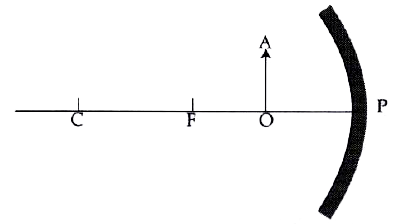Focus and pole
Step-by-Step Text Solution:
1. Definition of Pole:
- The pole is defined as the geometrical center of a spherical mirror. In the context of a concave mirror, the pole is the midpoint of the mirror's surface. It is the point where the principal axis intersects the mirror.
2. Definition of Focus:
- The focus is the point where parallel rays of light (rays coming from infinity) that strike the mirror converge after reflection. For a concave mirror, when parallel rays hit the mirror, they reflect and meet at a single point known as the focus.
3. Understanding the Distance:
- The distance between the pole and the focus is known as the focal length. This distance is crucial in optics as it determines how the mirror will focus light.
4. Visual Representation:
- In a diagram, the pole is typically represented as a red dot, while the focus is represented as a blue dot. The pole is at the center of the mirror, and the focus is located along the principal axis at a distance known as the focal length.
5. Summary:
- To summarize, the pole is the center of the mirror, and the focus is the point where light rays converge after reflecting off the mirror. The distance between these two points is the focal length.
- The pole is defined as the geometrical center of a spherical mirror. In the context of a concave mirror, the pole is the midpoint of the mirror's surface. It is the point where the principal axis intersects the mirror.
- The focus is the point where parallel rays of light (rays coming from infinity) that strike the mirror converge after reflection. For a concave mirror, when parallel rays hit the mirror, they reflect and meet at a single point known as the focus.
- The distance between the pole and the focus is known as the focal length. This distance is crucial in optics as it determines how the mirror will focus light.
- In a diagram, the pole is typically represented as a red dot, while the focus is represented as a blue dot. The pole is at the center of the mirror, and the focus is located along the principal axis at a distance known as the focal length.
- To summarize, the pole is the center of the mirror, and the focus is the point where light rays converge after reflecting off the mirror. The distance between these two points is the focal length.
Similar Questions
STATEMENT - 1 : Image formed by a convex mirror is always virtual, erect and diminished.
STATEMENT - 2 : In case of a convex mirror the image is erect and virutal, when the object is placed between focus and pole.
STATEMENT - 3 : In case of a concave mirror the image is real, when the object is placed between focus and centre of curvature.
View SolutionThe position of optical axis N1N2 of a spherical mirror, the source and the image are known (as shown in Figure ). Find by construction the positions of the center of the mirror, its focus, and the pole for the cases
a. A-source, B-image,
B-source, A-image.

View SolutionAssertion:- The image focus (2nd focus) and the object focus (1st focus) are on the oppostie side of the biconvex or biconcave lens.
Reason:- The radii of curvature of a biconvex lens and biconcave lens are on the opposite side of the lens.
View SolutionWhen the N-pole of a bar magnet points towards the south and S-pole towards the north, the null points are at the
View SolutionA boy of mass 50 kg is climbing a vertical pole at a constant speed. If coefficient of fricition between his palms and the pole is 0.75, then the normal reaction between him and the pole is (take g =10m/s2)
View SolutionFig. shows a concave mirror with its pole at P, focus F and centre of curvature C. Draw ray diagram to show the formation of image of an object OA.

View SolutionDraw ray diagrams showing the image formation by a concave mirror when an object is placed
(a) between pole and focus of the mirror , (b) between focus and centre of curvature of the mirror
(c) at centre of curvature of the mirror , (d) a little beyond centre of curvature of the mirror
(e) at infinity
View SolutionA pole of 50 meter high stands on a building 250 m high. To an observer at a height of 300 m, thebuilding and the pole subtend equal angles. The distance of the observer from the top of The pole
View SolutionA pole of 50 meter high stands on a building 250 m high. To an observer at a height of 300 m, thebuilding and the pole subtend equal angles. The distance of the observer from the top of The pole
View SolutionTwo identical thin bar magnets, each of length L and pole strength m are placed at right angles to each other, with the N pole of one touching the S-pole of the other. Find the magnetic moment of the system.
View Solution
